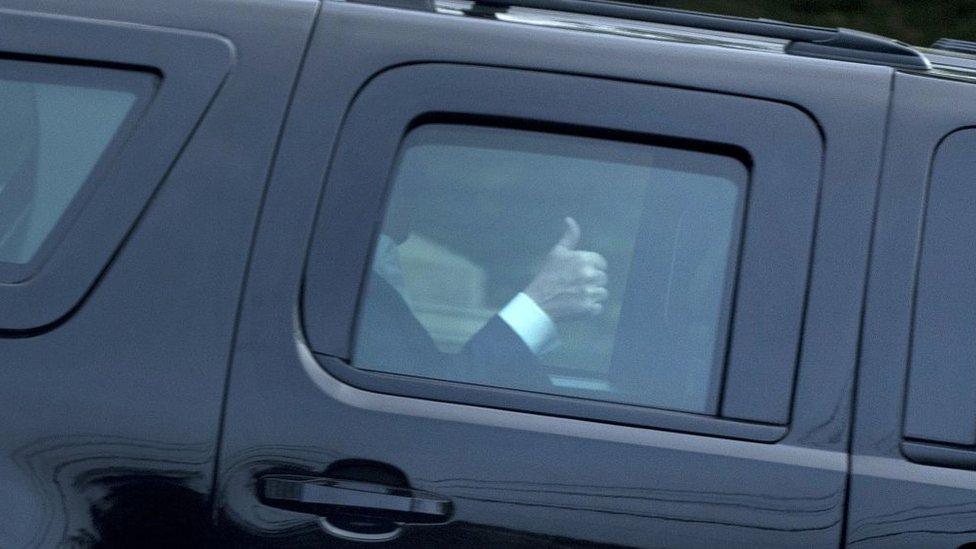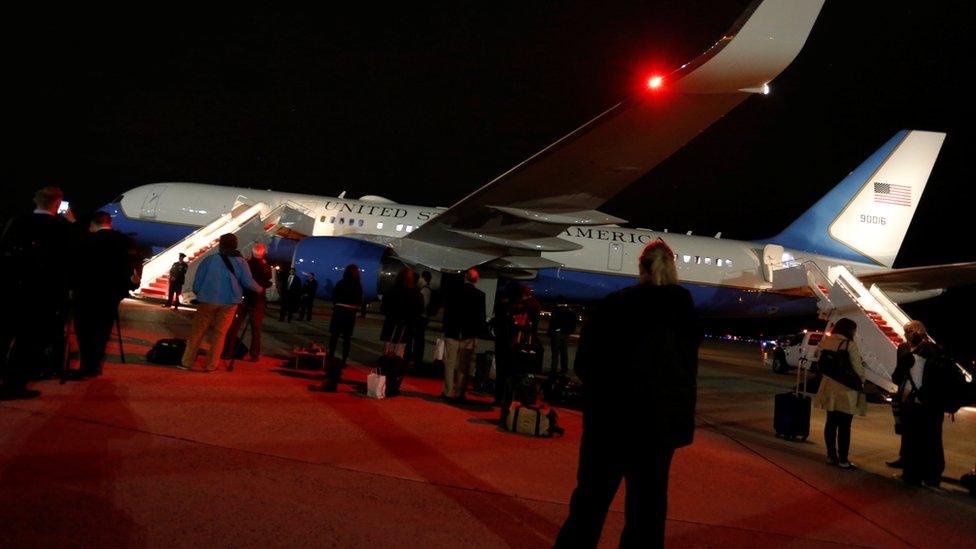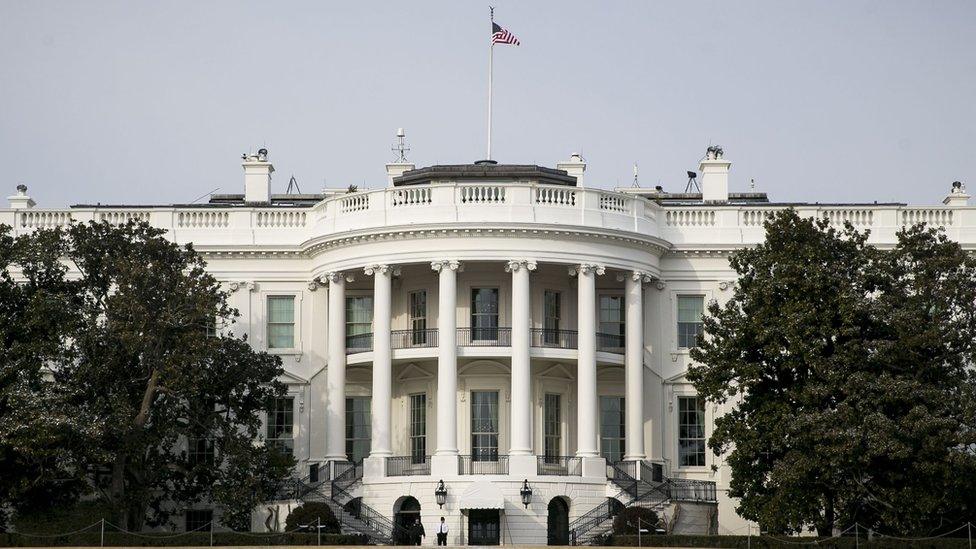Staying out of spotlight, Trump prepared an ousting
- Published

How US President Donald Trump spent his time before the firing of the FBI director - quietly and away from the public - sheds light on his decision-making.
In the days leading up to the president's momentous decision to fire FBI director James Comey, President Trump spent his time with members of his family and close aides.
The group didn't include his high-profile senior advisors, revealing the way that he was tightening the circle of trust before the bombshell announcement.
Earlier this month Comey spoke with Rod Rosenstein, the deputy attorney general, about the investigation into Russia's attempts to interfere in the November election. Comey made it clear that he was working hard on the investigation and had no plans to drop the matter or go easy on the president.
Comey also spoke with lawmakers about the bureau's investigation into the Russians, and about its investigation into the emails of Hillary Clinton. On 3 May he told members of Congress that he felt he'd approached both investigations in an impartial manner.
What do Trump supporters think about Comey's firing?
This did not sit well with the president, who was hoping that the investigation into his past ties with Russia would be dropped. Trump had expected Comey to make a public statement saying there was no investigation of him. He'd made sure Comey knew he was hoping for that statement, but Comey had refused to do it. That had gnawed away at Trump over recent weeks.
Trump became even more wary when Comey testified before Congress on 3 May. The president, as White House officials explained later, was inclined to remove him from his post.
In a termination letter written to the FBI director, the president laid out his complaint and explained the rationale for his firing: "While I greatly appreciate you informing me, on three separate occasions, that I am not under investigation, I nevertheless concur with the judgement of the Department of Justice that you are not able to effectively lead the Bureau."
Five days earlier - the day after Comey spoke with members of Congress - the president left on a trip to New York and then headed to New Jersey. For three days - from Thursday night until Sunday - the president was not seen by the public. He was staying at Trump National Golf Club in Bedminster, New Jersey, not far from New York City.

Trump appeared before the press on Sunday 7 May, after three days out of the spotlight.
While the president was spending time at his club, other members of the press pool and I - a small group of reporters who are responsible for tracking the president's activities on a daily basis - were waiting around in a hotel in nearby Branchburg. We weren't allowed to visit the resort. Instead White House officials would occasionally stop by the hotel and tell us that the president was having meetings - but wouldn't tell us with whom or what about.
Presidents - like everybody else - like to have down time and relax. They're also free to work wherever they want. But it was unusual for a president to disappear from the public for this long and without a more detailed explanation from his aides about his activities. As it turned out, he was thinking about the FBI director - and the possibility of his ouster.
On Sunday evening Trump rode in a motorcade through New Jersey, driving past red barns and horse pastures, but he was in a dark vehicle and couldn't be seen. Then he got on Air Force One to fly from New Jersey to Washington. That's when members of the press saw him for the first time since Thursday.
He and his daughter Ivanka and his son-in-law Jared Kushner were seated in a cabin in the front of the aeroplane. KT McFarland, the deputy national security adviser, was on the flight. Stephen Miller, wearing a navy jacket and a white shirt with no tie, paced around the cabin.
I didn't see HR McMaster, the national security adviser, or Stephen Bannon, the chief White House strategist. I was surprised because on most of the trips I'd gone on with the president, I'd seen Bannon on the aeroplane.
That evening I was sitting in the back of the aeroplane with the other reporters, and someone told me that Trump waved at us. During the short flight, the people in the front of the cabin were laughing and joking around.

Reporters and staff wait on the tarmac at Join Base Andrews on Sunday
Then the aeroplane landed - and something seemed wrong. Kushner and his family came downstairs and headed towards a dark sedan, but the president didn't.
Members of the travelling press pool wait until the president gets off the plane and gets on his helicopter, Marine One, before they leave the tarmac - and so I stood there.
It was cold and blustery, and I spent a long time looking at the windows of the aeroplane and trying to figure out what was going on. We were there for so long that even the Secret Service agents started to look bored. One of them yawned.
I asked White House aides about the delay, and they told me the president was in a meeting. "He didn't want to break it off," one of the aides told me later.
While we waited on the tarmac, an aide carried two or three golf clubs down the stairs, holding them close to his side so they'd be less visible. (Still they clanked together as he walked down the stairs - it's hard to hide golf clubs.)
At one point Kushner went back up the stairs of the plane. Every family has a mediator, someone who calms everyone else down, and he seems to play that role. After a while he came down the stairs again.
"Everything's OK," Kushner told me, talking about the president and his reasons for staying the plane. "He was just working on something."
Finally - after 45 minutes - Trump came out. He wasn't wearing a tie, and his hair looked messy. He gripped the handrail and walked down the stairs and headed for Marine Force One and back to the White House.
I'm still not sure whom the president was meeting with on the plane or why the meeting was so important that it couldn't be interrupted when the plane landed. McFarland wasn't in the meeting - at least I don't think she was. I could see her walking past the windows of the plane. White House officials haven't provided me with more of an explanation for what was happening on the plane.
One thing seemed clear, though: the president was preparing for the important announcement about the FBI director in a safe, cloistered environment, an atmosphere in which he was unlikely to be challenged in a dramatic way.
That changed, of course, on Tuesday when Comey was sacked, and people outside the president's circle found out about the president's plans. The relaxed, contemplative world that he'd created had come to an end.
Unlike previous presidents, he does not seem to have an established system either for his decision-making or for the rollout of major announcements. Trump may have thought long and hard about the termination of Comey, but analysts said that he didn't lay the groundwork for what would happen next.
"You'd think if you're going to fire someone, you'd have a successor lined up," said David Greenberg, the author of Nixon's Shadow: The History of an Image.
Right now the search is on for a new FBI director: stay tuned.
- Published10 May 2017

- Published10 May 2017
- Published11 May 2017

- Published10 May 2017

- Published15 December 2020
